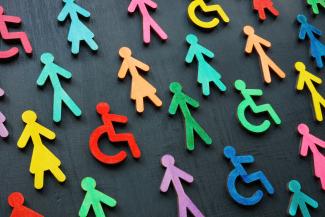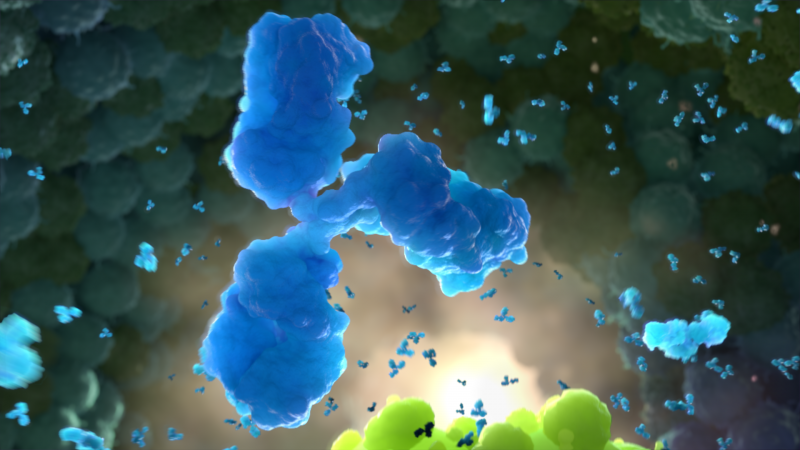Spotlight on: Disability or Diversity? Navigating the STEM Ed Journey

There are people who love science, and others who struggle with it – perhaps they don’t enjoy memorizing facts or doing lab work. But, for some, the struggles are different. Sometimes the struggle is related to individual disabilities. In this month’s article, we explore what educators can do to make science more accessible and inclusive for their students.
Our consideration begins with Dr. Karen Sadler’s story. Dr. Sadler has been hearing impaired since childhood due to a rubella infection her mother suffered during pregnancy. In an interview with the Vaccine Education Center team, Dr. Sadler described her school experience as a hearing-impaired person. Next, we look at how society frames disabilities and compare that framework with examples of disability being connected to unique strengths and skills. Finally, we focus on specific resources and tools that can help support students in the STEM classroom.
One person’s story
Editor’s note: More from Dr. Sadler’s interview can be found on the Parents PACK website.
Dr. Karen Sadler has a PhD in science education and a master’s degree in neuroscience, and while she is unable to hear as a result of her mother’s rubella infection during pregnancy, Dr. Sadler considers herself lucky that deafness was her only lingering effect. Although Dr. Sadler was born in 1956, elements of her journey still resonate today.
Early childhood and diagnosis
Dr. Sadler described, “They didn't check children’s hearing at that point like they do in the hospitals now with infants. I had a little bit of hearing when I was growing up, and I actually managed to meet most of my milestones as a child as far as speaking is concerned, but my parents got a little suspicious as I got a few years older when I wouldn't respond to them or my sisters … I should have been given a hearing aid from the age of three, but I did not get a hearing aid until I was 13 years old. My parents never learned sign language. I just learned to speak with my sisters and with my mom and dad. My parents included me in everything with my sisters.”
Elementary and middle school experiences
Dr. Sadler recalled, “Speech therapy started in first grade. The speech therapists did a good job teaching me to speak.” Although the speech therapy support was helpful, Dr. Sadler experiences issues in school from the outset. Despite her having normal intelligence, the school administration continually subjected her to IQ tests … “My parents got very, very upset [when I asked why I had to keep taking these tests. They] went to the principal and the superintendent of the school and both of those men had to apologize … because they had been trying to test me out of the school system … this was typical of the discrimination before the Americans with Disabilities Act.”
The school administrators were not the only ones who treated Dr. Sadler differently. She encountered bullying from her peers and challenges in the classroom centered around how content was disseminated and even where her desk was located. For example, CBS radio recordings were used to share information, putting Dr. Sadler at a disadvantage because she relied on lipreading to understand what people were saying. Likewise, her desk was in the back of the classroom, also a disadvantage for lipreading.
Dr. Sadler said she was lonely and would fill her time doing things, like reading and science. “My favorite thing to do was go to the library and grab a bunch of books. I read everything. I was a good reader. And that reading probably saved my education. Things started to get better in the 7th and 8th grade a little bit.” In the 7th grade, Dr. Sadler noted that the support of one teacher made a difference in her educational journey, “One of my best teachers was a science guy who used to play professional baseball. He was a real comedian, and he really took me under his arm. My father was an engineer, so between my father and this science teacher, I learned to love science.”
High school
During high school, Dr. Sadler started to feel more connected to her school community, “When I got into high school, everything changed. I started getting more involved in things. I actually learned to play the trombone. During my last year in high school, we moved to Pennsylvania. And that was nice because nobody knew about me, so nobody had previous expectations or feelings about my hearing or my lack of hearing. I would wear my hair down all the time, so people couldn't see my hearing aid. And if I didn't show it to them, a lot of people just assumed I was hearing.”
Dr. Sadler’s telling of her K-12 school experiences shows both the positive impact of acceptance and support and the negative impact of missed opportunities. While Dr. Sadler’s full story is decades in the making, today, students who could benefit from acceptance, support or small changes are in classrooms across the country. Are they being helped? Supported? What if we start with a shift in our perspectives on diversity itself?
Reframing disability as diversity
When people think of disabilities, they often think of physical impairments, but people can experience sensory challenges, psychiatric conditions, and nonvisible impairments that factor into their interactions and experiences. Given that “disabilities” are often viewed as things that hold an individual back or that must be overcome, it may be better to consider each individual as a whole, singular human being with multiple facets – including facets that may have traditionally been defined as disabilities. This type of multi-faceted approach can make people more open to recognizing each person’s sensitivities and strengths.
For example, in his article, “Disability as Diversity in STEM: A New Perspective,” Jonathan Kaufman, PhD, provides examples of how neurodiversity can be beneficial in STEM:
“A study published by The Journal of Autism and Developmental Disorders found that students with autism choose STEM majors at a higher rate than the general population. The study emphasized that those on the autism spectrum had a greater aptitude toward systemization and analysis. While it is harmful and exclusionary to generalize about the truly unique skill sets that people on the autism spectrum have, the study shows that there is a higher propensity for core skills, such as attention to detail, high levels of concentration and the ability to solve complex problems—all of which are beneficial to STEM professions."
Many instances of people thriving in their given professions or areas of interest – not only in spite of a difference, but sometimes because of it – exist. Check out these stories from the “STEM is for Everyone” series, which profiles “Scientists with Disabilities”:
- Wanda Díaz-Merced is an astronomer and astrophysicist with a PhD in computer science. She began experiencing vision issues associated with diabetic retinopathy in college and became fully blind by age 30. Initially, she thought she would not be able to continue working in her chosen field, but then she realized she could convert the numbers into sound to access her data.
- Ralph Braun had muscular dystrophy, unable to walk by the time he was a teenager. Dissatisfied with the wheelchair he was using, Braun became an engineer and entrepreneur, designing a better alternative and building his first motorized scooter in his early twenties. He then set up his own company, continuing to design, build and sell scooters. Eventually, he expanded his business to include configuring cars to accommodate drivers confined to wheelchairs and was active in his company until his death in 2013.
- Dr. Geerat Vermeij is a professor of geology at the University of California at Davis who studies the evolution of mollusks. Blind from a young age due to glaucoma, Dr. Vermeij uses his fingers to explore and observe mollusk shells for his studies. Dr. Vermeij noted in an interview that he believes being blind has made him a better scientist, "Being aware, to me, is so essential in science because by being aware, you're made a better observer, and observation is where really all of it begins, to me."
These are just a few stories that highlight how people can leverage their distinct abilities or perspectives to benefit their careers or accommodate their particular needs.
Concluding thoughts
Hopefully, you found the individuals in this story to be inspiring and the ideas to be thought-provoking. Science educators are in a unique position to help students realize their potential, and the STEM fields are a natural place for students to explore, learn and present solutions for the challenges that they encounter because the study of science centers around asking questions, experimenting, and problem solving. These skills will not only empower students as they navigate their educational journey, but such skills will also serve them throughout their lives.
Tools and resources
Wondering about ways to make your classroom more individualized or accommodating? Check out these resources that offer ideas for supporting the STEM educational journey of multi-faceted students:
- Disability as Diversity in STEM: A New Perspective (article)
- Neurodiversity: Discovering the Extraordinary Gifts of Autism, ADHD, Dyslexia, and Other Brain Differences (book)
- STEM is for Everyone: Scientists with Disabilities (webpage)
- A Desk Layout Alternative to Rows and Circles (article)
- Making Science Labs Accessible to Students with Disabilities (webpage)
- Working Together: Science Teachers and Students with Disabilities (webpage)
- Making STEM More Inclusive of People with Disabilities (article)
- STEAM Career Showcase for Students with Disabilities (YouTube playlist of multiple annual event recordings)
Do you have tools, resources, or approaches that you have found helpful in making your classroom supportive to all learners? We’d love to hear from you! Please contact us using this form or by emailing us at vacinfo@chop.edu.

